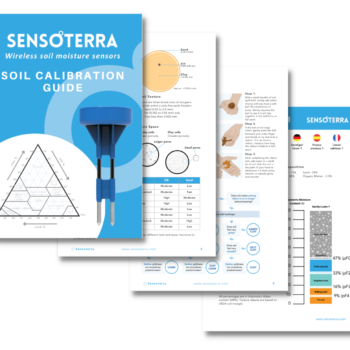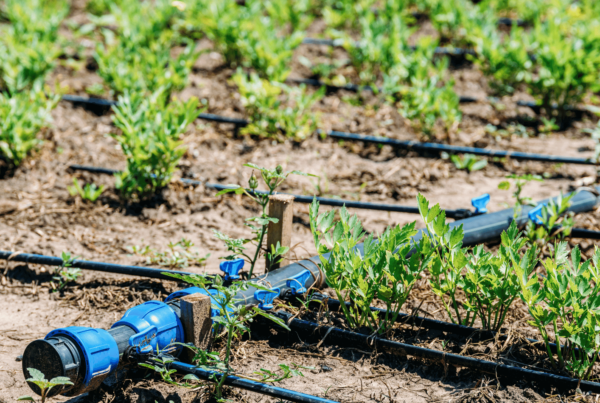Determining the right number of Sensoterra sensors for effective water management in urban environments is crucial yet often challenging. In this article, we look at the variables needed to consider sensor placement to ensure optimal coverage and insightful data collection tailored to urban green spaces, public parks, medians, and greenways.
Understanding Soil Moisture Dynamics
Soil moisture plays a pivotal role in sustaining urban greenery, influencing everything from plant health to water consumption. However, soil moisture levels can vary significantly even within small urban areas, making precise monitoring essential. Sensoterra sensors excel in providing accurate and localized soil moisture data, offering a cost-effective solution for urban water management.
Strategic Sensor Deployment
Rather than relying on a single expensive sensor, our approach emphasizes the strategic placement of multiple low-cost sensors throughout the urban landscape. This distributed sensor network enables comprehensive data collection, capturing variations in soil moisture across different zones and microclimates.

Determining the Optimal Number of Sensors
Several factors come into play when determining the number of sensors needed for urban water management:
- Terrain Variations: Altitude fluctuations within urban spaces can lead to disparate moisture levels. To address this, we recommend installing at least two sensors to cover high and low areas, providing insights into moisture dynamics across the landscape.
- Application type: Urban environments often feature diverse plant types, and application each with unique moisture requirements. Installing sensors tailored to specific plant species or groups ensures precise monitoring and targeted irrigation. Applications like, tree pits, planter, green roofs, road medians, greenways, parks, and sports fields each require their own management.
- Soil Composition: Different soil types prevalent in urban settings exhibit distinct moisture behaviors. By deploying sensors calibrated for each soil type, we can accurately monitor moisture levels and optimize watering schedules accordingly.
- Infrastructure Considerations: Factors such as underground utilities and drainage systems can impact soil moisture distribution. Integrating sensors strategically around these infrastructural elements provides valuable insights into localized moisture variations.
- Irrigation System Complexity: For irrigated areas or projects, it’s prudent to consider placing one sensor in each irrigation zone. This can be further optimized to one sensor per “X” irrigation zones. In drip irrigation systems or orchards, distributing multiple sensors along an irrigation line can yield valuable insights.
Scaling for Urban Spaces
In sprawling urban areas, the traditional approach of placing one sensor per hectare may not be feasible. Instead, we recommend dividing the area into manageable zones based on similarities in application type, terrain, plant type, and soil composition. This zoning approach allows for targeted sensor placement, maximizing data accuracy and cost-effectiveness.
Synergistic Data Integration
While satellite-based moisture data offers valuable macro-level insights, it complements rather than replaces on-site sensor measurements. By integrating satellite data with real-time sensor readings, urban planners and landscapers can make informed decisions regarding water allocation and conservation strategies.
Optimizing water management in urban environments requires a nuanced approach to sensor placement and data collection. With Sensoterra sensors, urban planners and green space managers can harness the power of precise soil moisture data to ensure sustainable and vibrant urban landscapes.
The Soil Calibration Guide
To support your sensor placement decisions based on soil types and moisture behaviors, we’ve compiled a comprehensive and free Soil Calibration Guide. It’s your compass for precision sensor deployment.
In the quest for optimized soil moisture management, remember that the secret lies in strategically positioning your sensors to unearth the mysteries beneath the surface. The journey to data-driven soil moisture insights begins with the right sensors in the right places.
About Sensoterra
Sensoterra develops low-cost, simple, and robust wireless soil moisture sensors, providing actionable insights that enable water management platforms and solutions. Our sensors are built to integrate into any platform with our unique ‘API first’ philosophy – offering freedom and flexibility for data integration. It is our mission to enable water management platforms and solutions worldwide. We help by ‘Making Sense of Water’. We produce simple, robust, and low-cost wireless soil moisture sensors that are easy to deploy and built to integrate. With proven success in the applications of smart city landscaping, environmental monitoring, and precision agriculture, the Sensoterra solution integrates seamlessly in existing water and land management platforms.
Learn more at www.sensoterra.com
Contact for more information, pictures and/or interview requests:
Jessica Nuboer
Marketing & Communications
Sensoterra
Email: [email protected]







